The Cold War stemmed from World War II. At the end of that war, the Allies and the Soviets joined forces to fight the Nazis.
Even before the war ended, Allied leaders met at the Yalta Conference in February 1945. During these meetings, the leaders tried to decide how to restore order in post-war Europe. Tensions initially arose between U.S. President Roosevelt and the Soviet leader, Stalin.
The Americans wanted all countries to have the right to hold free elections, even those under Soviet rule. Stalin wanted to establish nations that would serve as a buffer zone in case of another attack on Soviet territory. This conflict marked the beginning of the Cold War, which never developed into open armed conflict between the two powers. It was an ideological war, although there were also several regional wars at that time.
The conflict between the United States and the Soviet Union quickly divided the world into two factions. The United States and Western Europe (the Western Bloc) opposed the Soviet Union (USSR), which was allied with the communist countries (the Eastern Bloc).
In addition to being marked by regional conflicts, this ideological division was also influenced by the arms race, espionage, nuclear fear and space exploration. The Cold War lasted from 1947 to 1991.
Former British Prime Minister Winston Churchill described this global division as the “Iron Curtain.” After the end of World War II, the conflict worsened when Stalin sent his Red Army to set up communist governments in several Eastern European countries. The USSR wanted to gain strength by using the power of its neighbouring countries.
The United States reacted quickly, fearing that communist regimes would spread throughout Europe. Because Western European countries were in debt and weakened by the many years of war, the leaders could have decided to establish totalitarian communist regimes. The blocs were distinguished by their political and ideological positions. The Western Bloc favoured democracy and a market economy, and the Eastern Bloc promoted dictatorships and communism.
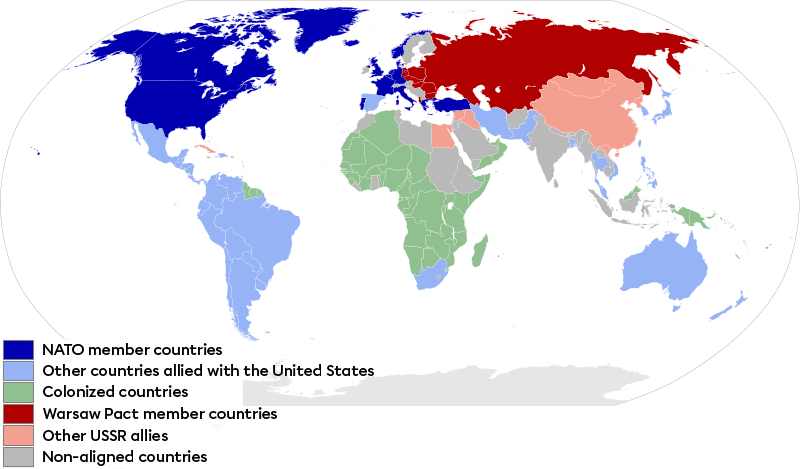
In 1945, Europe was devastated and lacked the economic means to rebuild its cities. The United States had a financial monopoly and a nuclear monopoly. The USSR had military strength with its Red Army as well as political prestige.
The fear of communism was growing in the United States. On March 5, 1946, Winston Churchill came out of retirement to urge the United States to act against the USSR’s invasive policy. He urged the U.S. president to fight the USSR as a joint effort to liberate Europe.
The end of the war also divided Germany’s territory. It was divided and occupied by the French, Americans, British and Soviets. The opposing blocs founded two new states: the Federal Republic of Germany (FRG) and the German Democratic Republic (GDR). The Federal Republic was part of the Western Bloc while the Democratic Republic was part of the Eastern Bloc.
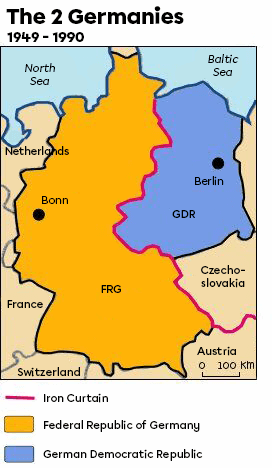
U.S. President Truman first developed the Truman Doctrine. Its aim was to help all governments under threat to counter the rise of communism. This decision had an impact in Greece and Turkey where civil wars were raging.
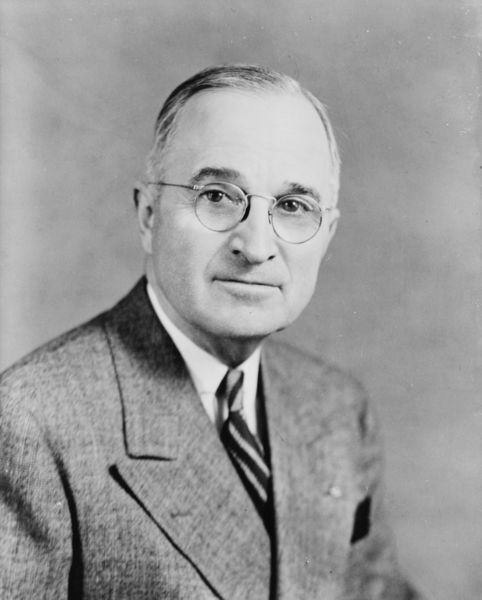
Truman’s Secretary General, George Marshall, went a step further and devised a plan to prevent the countries of Western Europe from becoming communist countries. On June 5, 1947, the Marshall Plan proposed economic aid from the United States to Europe. This interest-free loan provoked strong reactions and several countries expressed interest, including the USSR.
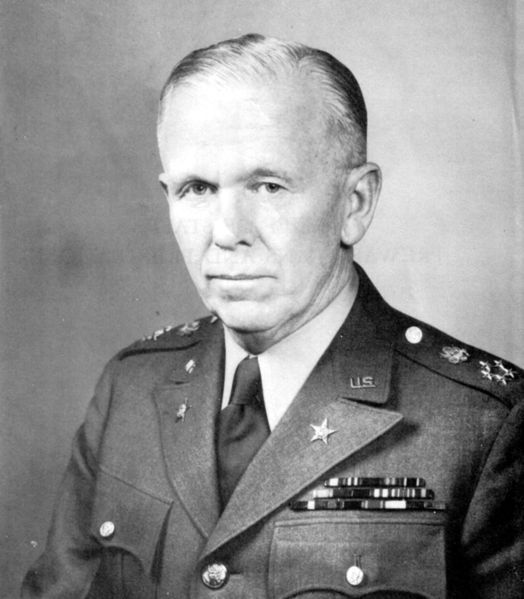
On the other hand, the Marshall Plan set conditions for countries to receive aid, which included adopting a democratic and liberal policy and buying American products. The Soviet Union soon rejected this proposal because of the imposed conditions. All of Eastern Europe also rejected the Marshall Plan.
A total of 16 countries benefited from U.S. aid. Approximately 72.5 billion US dollars were invested in Western Europe to rebuild the economy of these countries.
This plan was effective for a number of reasons: aid was offered in countries that were already developed, where structures and institutions were already in place, and where education and respect for human rights were assured. This explains why a plan similar to the Marshall Plan would be ineffective in underdeveloped countries, where there was a risk that the aid would be dispersed through administration or corruption.
The Soviet Union reacted quickly to the United States’ offer, setting up an information office in 1947 to promote unity among the communist parties. In 1949, the USSR also founded a mutual economic assistance council, Comecon, which promoted economic development. Stalin, however, imposed much stricter control over political parties.
The Marshall Plan proved to be much more effective than Soviet aid. It was better organized, as the financial support was spread out over four years, which facilitated sustainable economic recovery. The support provided both financial aid and equipment. The countries that received aid benefited immediately from the positive effects, boosting investment and consumption. The Marshall Plan clauses ensured that democratic regimes thrived in Western Europe and boosted U.S. imports. In 1953, George Marshall was awarded the Nobel Peace Prize.
The Marshall Plan was made possible by the founding of the Organisation for European Economic Co-operation (OEEC) on April 16, 1948. The purpose of this organization was to help distribute U.S. aid. This way, the United States did not have to decide on the portion received by each country. The European countries decided among themselves how to distribute the aid based on need.
A few years later, in September 1961, the OEEC became the OECD, the Organisation for Economic Co-operation and Development. This organization, which still exists today, promoted policies to stimulate sound economic expansion, both in member countries and in developing countries.
The USSR refused the Marshall Plan and membership in the OEEC in order to preserve its national sovereignty. All the countries occupied by the Red Army also refused.
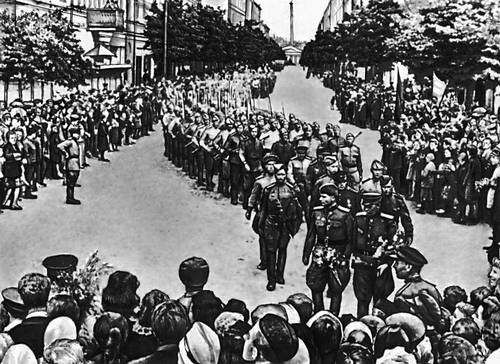
In July 1947, the Czechoslovakian government unanimously accepted the clauses of the Marshall Plan. Stalin, whose armies occupied Czechoslovakia after the fall of the Nazi regime, immediately imposed his veto power to prevent the Marshall Plan from being adopted in Czechoslovakia. During fall 1947, the country’s communists isolated the country and foiled plans for an alliance between Czechoslovakia and France. Politics were soon marked by conflicts between communists and non-communists.
One of the communist ministers gradually replaced police commissioners with communist activists. On February 17, 1948, the non-communist ministers demanded the withdrawal of the communist police officers, which was refused. On February 19, the Communist Party mobilized its militants. The next day, all the moderate ministers resigned.
On February 22, the communist police entered Prague and made their first arrests. On February 25, to avoid civil war, the President of the Republic resigned and let his opponents form a new government. The coup d’État was successful. On March 10, the Minister of Foreign Affairs, who had opposed the coup, was found murdered.

On May 30, rigged elections secured power for the communists with 90% of the vote in favour. The Czechoslovak coup could have triggered a third world war. Stalin announced his plan to occupy all of West Germany.
Faced with Stalin’s threats and wanting to avoid another world war, the Western democracies created a new military alliance. On April 9, 1949, the North Atlantic Treaty Organization (NATO) was formed. All the signatories agreed to come to the aid of the other signatories in the event of an attack. Members of this defensive alliance included Canada, the United States, Belgium, Denmark, Italy, France, Iceland, Luxembourg, the Netherlands, Norway, Portugal and the United Kingdom. Greece, Turkey and the Federal Republic of Germany (FRG) also joined NATO.
The Warsaw Pact was signed on May 14, 1955 by the USSR and 7 satellite countries: Albania, Bulgaria, Czechoslovakia, Hungary, Poland, German Democratic Republic. The Soviet Union commanded the alliance. This pact was a treaty of friendship, cooperation and mutual assistance. It was signed to counterbalance the NATO alliance. The Warsaw Pact was open to all countries with approval by the signatory states. The USSR and the Red Army violently repressed any attempt by member countries to abandon the Warsaw Pact.
Hungary wanted to stay neutral in the conflict in 1956, which led to the Hungarian Revolution and the involvement of the Red Army. The Army crushed the resistance in Hungary within 2 weeks.
When the Soviet authorities realized that many East Germans were leaving the GDR for West Germany, they decided to build a wall that would reduce the number of people leaving to go west. On the night of August 12, 1961, a fortified wall was built to divide the city of Berlin into 2 zones: the Soviet zone, separate from the French and British zones. The wall was basically an impassable border between East and West Berlin.
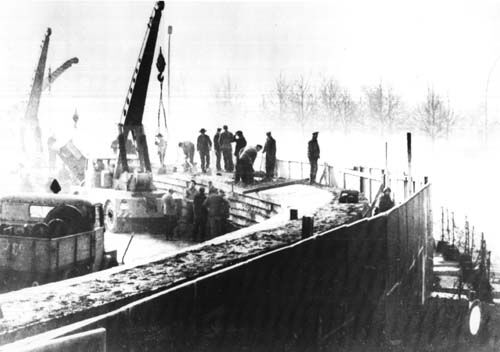
This Wall of Shame, as it was called by many Westerners, consisted of a concrete wall, barbed wire and ditches. Rail links were also cut off between the two areas. Even the doors and windows on the division line were barricaded and blocked. The wall spanned 43 kilometres in Berlin. It was also built on other sections of the border between the Democratic Republic and the Federal Republic. The wall in these areas created a division that was 112 kilometres long.
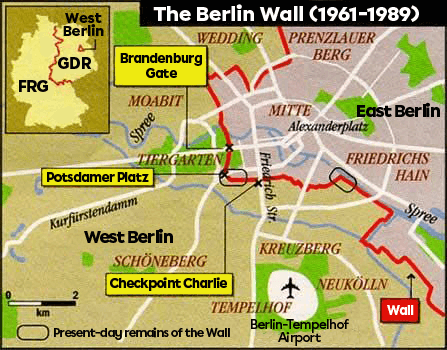
The communist government wanted to prevent German nationals from escaping to the Federal Republic. While the Berlin Wall stood, 239 attempted escapees were murdered by customs officers. An estimated 5000 people managed to cross the wall.
The signing of the alliance pacts led to an arms race, particularly nuclear weapons since the fear of nuclear power had reached its peak. Schools practised nuclear attack drills and several fallout shelters were built. All states invested heavily in nuclear research, testing and weapons development.
Everyone lived under the threat of a nuclear war. The bombings of Hiroshima and Nagasaki showed the world what was possible. People saw the aftermath of these explosions which included thermal and nuclear radiation, shock waves, massive destruction, brutal deaths and disease.
This fear was heightened by the division of the world into 2 blocs and the proliferation of nuclear weapons in several countries. Despite treaties being signed to limit the increase of nuclear weapons, the United States and the USSR each had roughly 50 000 nuclear warheads in the early 1990s.
In 1962, the Cold War almost turned into an open war during the missile crisis. The USSR had quickly joined the United States in developing nuclear weapons. However, these weapons were not capable of crossing the distance between Soviet territory and the U.S. soil.
In May 1962, Khrushchev asked Fidel Castro if he could place his missiles on the island of Cuba. Castro accepted the offer because Russian missiles on Cuban territory would help its defence. On October 15, 1962, military photos taken by the U.S. Air Force revealed that missile launch bases were being built in Cuba. U.S. President John F. Kennedy immediately formed a group of 12 advisers to control the crisis. This group spent 7 days extensively debating the issue to resolve the impasse.
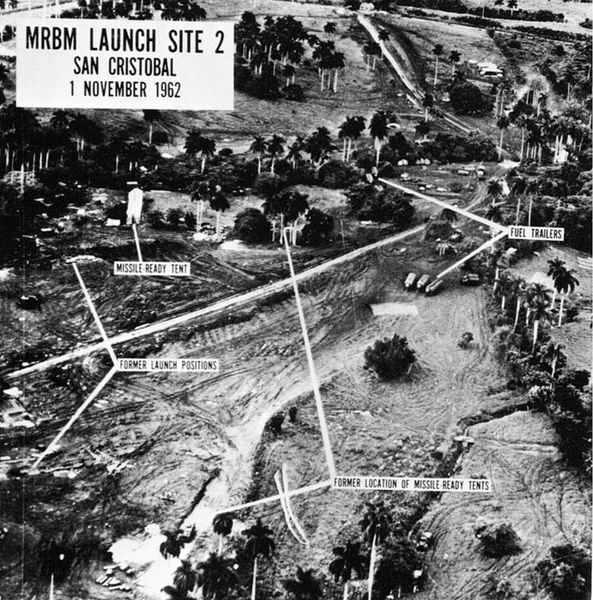
On October 20, U.S. cruisers were preparing to blockade the island of Cuba. On October 22, John F. Kennedy officially announced to the public that missiles had been discovered in Cuba. In the same statement, he announced that any missile launch would be considered a direct attack by the USSR on the United States. Kennedy ended his speech by demanding that the missiles be immediately withdrawn from Cuba.
Khrushchev criticized America for its attitude and for interfering with political matters strictly related to Cuba. On October 26, the USSR agreed to withdraw its missiles on the condition that the United States promised not to attack Cuba. The next day, a U.S. plane was destroyed while flying over Cuba, on Castro’s orders. The USSR demanded assurance that the United States would not attack Cuba, and that the U.S. military withdraw its missiles from Turkey.
On October 28, Kennedy responded to the first offer from October 26, but ignored the requests made the day before. He agreed to the proposed compromise. Khrushchev then announced the destruction of the Cuban missile bases and nuclear war was averted. Despite the high level of tension between the different factions, all the leaders were aware of the risks of nuclear war and the destruction it could bring.
Since this crisis was largely due to the lack of effective communication between the United States and the USSR, the leaders set up a direct telephone line between the two seats of power: the White House and the Kremlin, allowing the leaders to talk to each other right away whenever necessary.
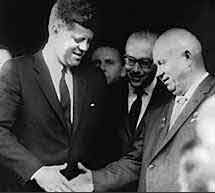
The missile crisis and the fear it created led to Détente, a period of peace between the USA and the USSR.
During the Cold War, both the United States and the USSR set up spy agencies: the United States created the CIA and the USSR, the KGB. Both agencies trained spies to gather information that could be used to organize coup d'États, plots and assassinations. Many spies also engaged in counter-espionage to expose enemy spies.
Espionage did not lead to direct action, as both powers were equally afraid of open nuclear war. However, governments captured spies from the opposition as a political move. The best known case is that of the Rosenbergs: a couple living in the United States accused of passing information about the atomic bomb to the Soviets. They were accused of treason and sentenced to death.
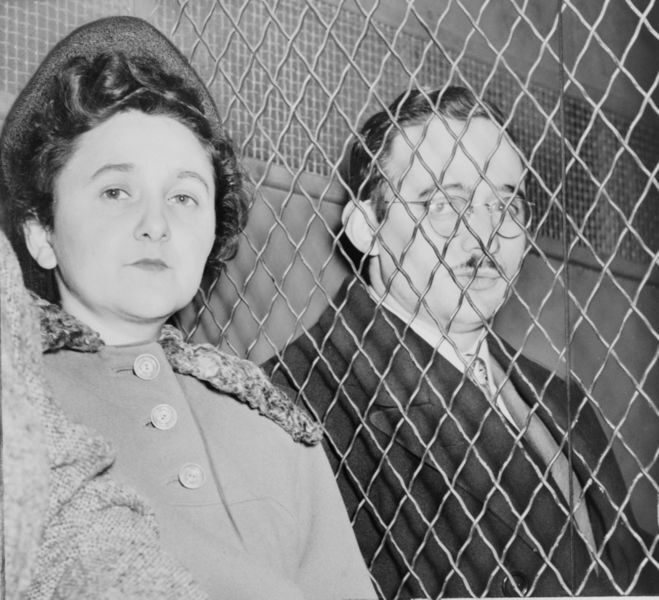
The Cold War created a real fear of communism in the United States. Some people were afraid that communists would take over the country and impose a dictatorship based on the Soviet model. Despite these growing fears, Truman wanted to avoid inadvertently creating a right-wing totalitarian country through attempts to combat left-wing totalitarian states.
McCarthy did, however, recommend creating a list of potential communists who should be removed from positions of power. He was given the power to set up institutions to identify supporters of the USSR and communist parties.
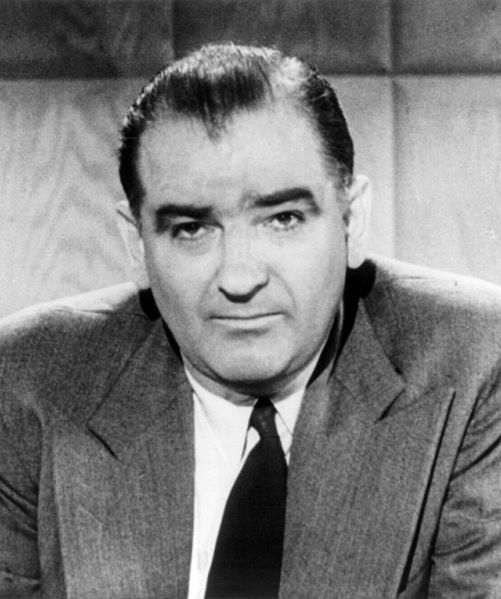
These institutions were authorized to conduct police investigations based solely on suspicion. McCarthy unleashed a witch-hunt during which he saw communists everywhere among civil servants, journalists, intellectuals, filmmakers, etc. Anyone who asserted left-wing political ideas was automatically suspected of being a communist. Several important figures were convicted during this witch-hunt, including George Marshall and Charlie Chaplin. Chaplin was banned from setting foot on American soil, where he would have been arrested and imprisoned.

On December 2, 1954, the White House put an end to McCarthyism after thousands of investigations, resignations of federal agents and dismissals. This put an end to this period of hysteria and paranoia.
After the Cuban missile crisis, the USSR and the United States agreed to renounce their crusades against one another. Each country agreed not to intervene in each other’s areas of influence, even if the policies went against their ideology. This decision was a sign of the desire to preserve peace and avoid escalation leading to a world war.
The USSR still hoped to have the same number of nuclear weapons and warheads as the United States, and succeeded in doing so in 1968. Heads of state became concerned by the growing number of nuclear weapons. To limit these concerns, they signed several agreements. In 1963, the Treaty banning nuclear weapon tests in the atmosphere, in outer space and under water attempted to end nuclear testing in the atmosphere. France and China refused to sign it.
In May 1968, countries signed the Treaty on the Non-Proliferation of Nuclear Weapons. This agreement stipulated that countries that possessed the atomic bomb would not build more of them or help other countries to do so. Countries that did not possess nuclear weapons agreed not to produce them. Neither France nor China signed this new agreement. In 1969, the United States and the USSR committed to limiting the number of nuclear weapon launch sites. These agreements are known as SALT (Strategic Arms Limitation Talks).
Several treaties were signed in Europe to keep European borders stable. Through one of these treaties, in 1972, the two Germanies mutually recognized their borders. In 1973, the two republics joined the UN. The Helsinki Accords also marked an important turning point in the Cold War. Signed on August 1, 1975, these treaties established European borders and demanded respect for human rights in the USSR. However, the Cold War was not over yet, as several regional conflicts were still creating tension between the two blocs.
Stalin died in 1953. His death led to a political crisis which was resolved when Khrushchev took power and control of the country.
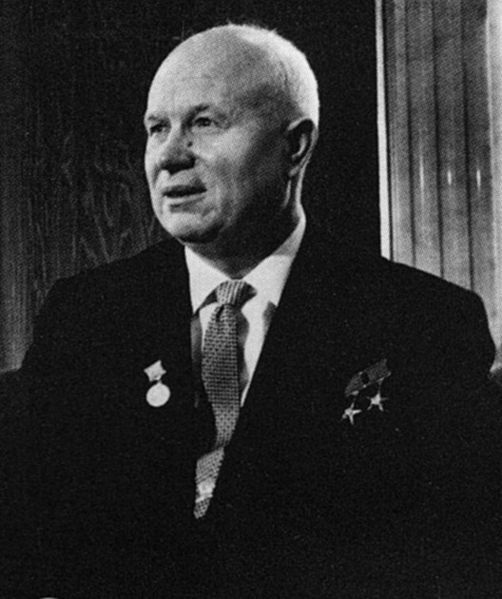
After taking power, Khrushchev wrote a report on communist regimes. This report, which was initially read to a select committee, was soon made public worldwide. Khrushchev was very critical of Stalin’s cult. More importantly, he expressed his own doubts about the communist regime, proposing certain changes. Khrushchev’s report caused a crisis between the communist parties and their leaders. Some of them supported the reforms proposed by the new Soviet leader, while others opted for a more conservative communist regime.
This report sowed doubt in communist countries, and gave rise to a growing democratic will. This was the case in Poland where the Prime Minister could not contain the protests. In response, he declared a state of war to stop the democratic push.
Mikhail Gorbachev took over leadership of the USSR in 1985. Feeling the power of the communist party crumbling due to criticism, he tried to reform the USSR and adopt new policies. By promoting disarmament and international cooperation, Gorbachev’s policies helped end the Cold War. Gorbachev also convinced U.S. President Ronald Reagan to cut his nuclear forces by half. For the first time since 1945, the two world powers had a truly moderate discourse. The USSR aimed for reconciliation with Europe and the United States.

Internally, Gorbachev wanted to establish a more transparent regime. He also tried to save the communist regime by implementing several reforms that moved away from more traditional communism. The reforms he tried to implement caused a number of crises within the USSR.
In May 1989, many Germans fled through Hungary, which had open borders. Several protests took place in East Germany. Thousands of Germans headed for Hungary while others were demanding an easier right of passage to the west. Meanwhile, Gorbachev asserted that he would not interfere with opening the gates of the Berlin Wall or the unification of Germany.
On November 7th, Germany’s communist government in East Berlin announced its resignation. It also granted its citizens permission to travel abroad without restrictions. When the people of Berlin heard this announcement, thousands of people headed towards the wall to cross it. The customs officers, who couldn’t keep up with the demand, let people pass through without question. The wall was open and anyone could pass through easily. On the night of November 9 to 10, 1989, groups of young people tore down the wall of shame. The fall of the Berlin Wall ended 50 years of separation. On October 3rd 1990, the unification of Germany was official.
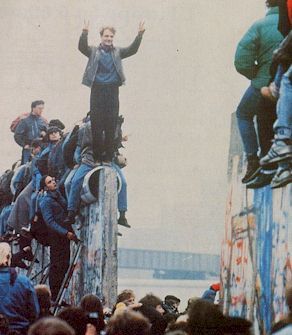
Not everyone was happy about Gorbachev’s reforms. There were several internal crises and the Soviet regime began to crumble. On June 12, 1990, Russia, then led by Boris Yeltsin, officially declared its independence. Without Russia, the USSR lost much of its power. On August 19, 1991, Boris Yeltsin overthrew Gorbachev and took power.
On December 21, 1991, the USSR was dissolved. The Commonwealth of Independent States (CIS) was formed. On December 25th Gorbachev left the Kremlin. After the USSR fell, the people requested that Leningrad change back to its original name of St. Petersburg. The fall of the USSR officially marked the end of the Cold War.